- Dickinson Homestead and Evergreens Merge
- From Bombs to Books
- Prof. Dudley Towne
- Thomas H. Wyman '51
- Trying on the World
- Physics Goes Mobile
- College Names New Editor
- Alumni Sons and Daughters
- From the Folger
- Verbatim
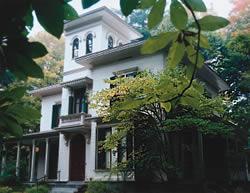 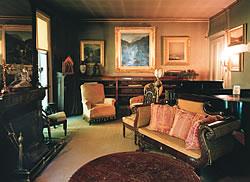 Both outside and in, The Evergreens is a snapshot of an era, a moment in time. |
Dickinson Homestead and Evergreens Merge
The Evergreens, the ivory-colored Italianate villa of Austin Dickinson (1829-95), a treasurer of Amherst College and brother of the poet Emily Dickinson, has long stood in the shadow of the solid Federal brick of the Dickinson Homestead (1813) next door. The trustees of the college, which has owned the Homestead since 1965 and keeps it open to the public, and the Martha Dickinson Bianchi Trust, the trustee of The Evergreens, recently agreed to a partnership. In January, the two boards asked the regional Probate Court for approval to transfer ownership of The Evergreens to the college. The Dickinson Homestead and The Evergreens will compose the new Emily Dickinson Museum.
The new museum, incorporating the homes of both the reclusive poet and her more gregarious brother and sister-in-law, may bring new light to the image of Emily Dickinson in her family and community. Polly Longsworth, Dickinson biographer and chair of the Trustees of the Martha Dickinson Bianchi Trust, says, “Throughout the poet’s creative life these homes were part of the same estate, the two families sharing love for Sue and Austin’s children, produce from the garden and personal secrets. There’s bound to be reinterpretation of how the Dickinsons interacted.”
Northampton architect William Fenno Pratt designed the Evergreens for the poet’s brother and sister-in-law, Austin and Susan Dickinson, at the time of their marriage in 1856. The lives of the Dickinsons at the Homestead and Evergreens were closely linked. Austin and Susan lived at the Evergreens until their deaths in 1895 and 1913. Austin Dickinson was an influential lawyer and politician and the treasurer of Amherst College from 1873 to 1895. The Evergreens was where the Dickinsons entertained contemporary celebrities such as Frederick Law Olmsted, Ralph Waldo Emerson and Harriet Beecher Stowe. The Dickinsons also amassed an eclectic collection of contemporary art, which remains on the walls.
Dallas Morning News architectural critic David Dillon has described the Homestead as “a palimpsest of changing architectural tastes and styles as revealed in a single house in a small New England town over nearly two centuries.” But The Evergreens evokes a moment. Grace Glueck, writing in The New York Timesafter the house was first opened to the public in 1999, marveled at the “peaceful decrepitude” of The Evergreens, which she described in its inviolate neglect as “a shrine to Victoriana . . . . The house, with its 10 main rooms and a number of smaller ones, is a trove of Victorian antiques and arrangements.”
Austin and Susan’s only surviving child, Martha Dickinson Bianchi, remained in the house and preserved it without change until her death in 1943. Her heirs—Alfred Leete Hampson and later his widow, Mary Landis Hampson—recognized the tremendous historical and literary significance of a site left intact. The Martha Dickinson Bianchi Trust was founded to preserve The Evergreens as a cultural resource. Dickinson family furniture, household accoutrements and decor selected and displayed by the family during the 19th century still furnish the house. The house and grounds—as a restoration in progress—provide a context for appreciating Emily Dickinson’s private world “within the hedge.”
For several years the Homestead and The Evergreens have worked collaboratively on tours, public programs and other projects. In 2002, the college and the Martha Dickinson Bianchi Trust completed an exploratory market study and business plan. Its conclusions support the long-term sustainability and success of a combined historic literary site.
Once the museums are legally joined, the operations of the two Dickinson houses will be merged. The current administrative staffs of the Homestead and The Evergreens will remain in place to manage the new museum. A new governing board is being formed to oversee the museum’s future development.
Photos: Frank Ward
From Bombs to Books

During the Cold War, one of the Soviet Union’s primary targets would have been Amherst, Mass. The Russians had nuclear missiles aimed at the town not because they hated higher education, but because a bunker on the side of the Holyoke Range housed a backup command center for the Strategic Air Command in Omaha. If the central base at Omaha had been destroyed, control of nuclear war would have switched to Amherst. You can see that dark history today in the rusted warning signs at the bunker’s gates, the massive concrete and lead walls and ceilings built into the mountainside, and the now-vacant control room with signs that say “Senior Battle Staff Only.”
Because of the bunker’s ominous background, its current use is all the more striking: it is owned by Amherst College and, since 1994, has been filled with books from Frost Library. Now it is also the depository for books from the other Five Colleges, which in November began leasing 10,000 square feet of the bunker from Amherst College. The depository is needed because all of the schools’ libraries have growing collections of books and limited space in which to store them. Remodeling the bunker was much cheaper than building additions to the libraries, says Will Bridegam, librarian of the college and the mastermind behind the purchase and conversion of the bunker.
Originally the bunker was intended for Amherst alone, an idea that came about because the college had too many pressing priorities at the time and couldn’t justify the expense of a new library building. “As we were planning for it,” Bridegam says, “it occurred to me that what’s good for Amherst would be good for the other four institutions in the valley. I checked with my colleagues at the other schools, and they said yes, they could use that kind of facility, too.” The schools then pursued grant money to develop and run the depository. The Mellon Foundation provided a major grant to start the project, with subsequent support from the Davis Educational Trust and the Arthur Vining Davis Foundation. “This is extraordinary,” Bridegam says. “These three foundations are willing to support us in this, although other libraries had not been terribly successful in interesting the foundations. We found that what interested the foundations most was that the colleges were willing to relinquish ownership of their books, that they could own these things in common. As far as I know this is the only example of this in the country.”
The Five College space is in a separate section of the bunker from the Amherst depository and features an unusual system for maximizing book storage. The books—mostly serials and government documents that are least often requested from the libraries—are not stored by call number or the Dewey Decimal System (which was invented by Melvil Dewey, Class of 1874). They are not sorted by subject. Rather, the books are sorted by size, with each shelf holding only books of the same height. And the books are not shelved spine out, but in long cardboard trays, packed in whatever direction most efficiently fills the space. The trays, in turn, are shelved end out, and each is given a distinctive code that’s entered into the depository computer. Because it is impossible for anyone to find a given book without knowledge of the computer codes, users are not allowed into the depository but must instead request the books through their library. To further save space, the bookcases are motorized and ride on tracks to minimize aisles. According to David Spoolstra, the librarian for the Five College depository, the unusual storage system allows the depository to hold twice as many books as conventional library systems. He also notes that the bunker has the added benefit of having floors that can hold 500 pounds per square foot. It has the additional benefit of offering bomb-proof protection for the books, as well as constant temperature and humidity.
As of January, Mount Holyoke, the University of Massachusetts and Amherst had delivered books to the depository. Smith and Hampshire Colleges planned to follow suit through the spring. Spoolstra says it will take several years to fill the space.
Photo: Frank Ward
Prof. Dudley Towne
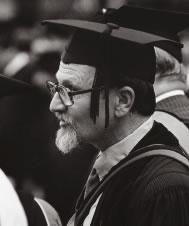
Dudley H. Towne, the Emily C. Jordan Professor of Physics, Emeritus, died November 25 at his home in Amherst at the age of 78. Towne taught at Amherst for 45 years, or, as his colleague Professor Emeritus Robert Romer observed, for one-quarter of the college’s existence. “He was a great teacher of physics and the liberal arts,” says Professor of Physics Kannan Jagannathan. “Rigorous, elegant and demanding, he was loved or at least admired by generations of students. To his colleagues who could appreciate more fully all of the power and beauty of his mind, he was an inspiration and a generous guide.”
Towne’s main research focus was wave phenomena, and his textbook on that subject, Wave Phenomena, is widely used. Although most colleagues recall his teaching approach as elegant and restrained, he knew how to use drama to get a point across: When he was teaching students the Maxwell formulas—the essential, but very difficult, foundation of electro-magnetism—he would perform a striptease he called “Climbing Mt. Kilimanjaro.” As he explained each successive layer of logic underlying the formulas, he would remove another layer of clothing. As the lecture progressed, the students’ anticipation—and attention—increased until he reached the final layer, his undershirt, on which were printed the Maxwell formulas.
His choice of a title for the Maxwell lecture was not coincidental. Towne traveled widely, including one especially memorable trip up Mt. Kilimanjaro, which was all the more challenging for him because he was an insulin-dependent diabetic. He had a tremendous gift for languages, and whenever he traveled he would make a point of learning the local language first. At the time of his death, he spoke 11 languages, including his first conquest, Chinese.
He learned Chinese during World War II, while he was the chief radio operator at theater headquarters in Chungking, China. The highlight of his military career came when he received a communication from General Douglas MacArthur himself with orders to broadcast it on all frequencies. The communication was for the Japanese emperor, ordering Japan to cease hostilities and giving precise instructions for surrender.
Towne’s World War II uniform played a role in one of the most significant aspects of his life, his sexuality. After wrestling with his sexual identity for the first 54 years of his life, Towne finally came to grips with it in 1978, and told College President John William Ward that he was gay. It was a bold move for any college professor in those days, and Towne was afraid the admission might end his career. But, as he told the Daily Hampshire Gazette, Ward was not only receptive, but supportive. “His reaction,” Towne said, “was that there were gay students who came to him, and now he would have someone for them to go and talk to.” Once Towne embraced his sexual identity, it became a central element of his life. He became active in support groups, gay hiking clubs and other organizations. In 1993, he took his involvement further when he went to Washington to join a march protesting the government’s position on gays in the military. President Clinton had ordered the ban on gays to be lifted, but Colin Powell, then Chairman of the Joint Chiefs of Staff, refused to follow the order, prompting the protest. Towne took his World War II uniform out of mothballs, made a sign saying “Colin Powell is Afraid of Me!” and ended up in the front row of the march. A picture of him taken at the march appeared in a number of newspapers and even on a postcard, something of which Towne was particularly proud.
Towne had an unusual countertenor voice and a great love of music. He sang with several local ensembles, including the Hampshire Choral Society, Smith/Amherst Chamber Singers, Da Camera Singers and the Gay Men’s Chorus. He first developed his interest in singing as a high-school student performing Gilbert and Sullivan operas in Stamford, Conn., and pursued it through his undergraduate studies at Yale and his graduate work at Harvard, where he received his Ph.D. in 1951.
“He was famous in my family,” said Romer, who worked with Towne through most of his time at Amherst, “for calling at 3 o’clock in the morning and saying, ‘Go out and take a look at the rings around the moon,’ or ‘Did you know there’s a really spectacular display of the aurora borealis out there?’ ”
Towne was also a philanthropist. He donated an $18,000 grand piano to the Northampton Community Center, and when the local community was unable to raise $200,000 to restore the Amherst Cinema, Towne donated all of the money himself. According to Professor Emeritus of Physics Joel Gordon, when Towne was a visiting professor at Universidad del Valle in Cali, Colombia, in the ’60s, he set up a program to bring Colombian students to Amherst, Williams and the University of Massachusetts. His final donation was his extensive papers, which he gave to the Amherst Archives and Special Collections just before his death.
He is survived by his sister, Will Towne Curtis, and brothers Robert and Stephen, as well as seven nieces and nephews. A memorial service for Dudley Towne will be held at the college on April 27, and his ashes will be interred next to those of his mother and father in Amherst.
Photo: Gabriel Cooney
Thomas H. Wyman ’51
Thomas H. Wyman ’51, chairman emeritus of the Board of Trustees, died Wednesday, Jan. 8, after a brief illness. He was 73.
A Phi Beta Kappa graduate with a major in English, Wyman was a member of Psi Upsilon and an all-American soccer player. He first served Amherst as an alumni trustee from 1976 to 1982, when he became a term trustee. In 1986, he was elected the 15th chair of the Amherst board, a position he held until May 1992.
Wyman led several large companies during a long and distinguished career. Chairman and CEO at CBS from 1980 to 1986, while the network was at its peak, he began his career at Nestle, then served as senior vice president and general manager of the Polaroid Corporation, where he also was chair of the management committee. In 1975 he was named president and CEO of the Green Giant Company. Four years later Wyman was named vice chairman of Pillsbury when that company acquired Green Giant.
Wyman recently captured national attention when he resigned his membership at the Augusta National Golf Club, where the Masters Tournament is held, to protest the club’s policy prohibiting women members.
“Tom Wyman was a giant of his generation, and he has left an indelible impression on his college,” said Board Chair Amos Hostetter, Jr. ’58. “His most lasting impacts were the result of his finely tuned moral compass. At Polaroid, he artfully guided policies on the allowable uses of that company’s identification products in South Africa. He was an outspoken advocate of civil rights and public education in the Boston community when few business leaders were willing to be engaged. On the Amherst board, he was a moving force in important decisions, including the abolition of fraternities—not a popular decision at the time, but the morally right decision. Tom Wyman set high standards in everything he did,” Hostetter added. “He will be sorely missed, and we are proud to claim him as one of our own.”
Wyman is survived by his wife, The Rev. Dr. Deborah “Debbie” Little; four children, Peter H. Wyman, Michael B. Wyman, Thomas H. Wyman, Jr. ’84 and Lisa B. Wyman; three sisters; and several grandchildren. He was predeceased by Elizabeth Minnerly Wyman, who died in January 2002.
A more detailed remembrance is included in the In Memory section of Alumni Online Services (log-in required).
Trying on the World
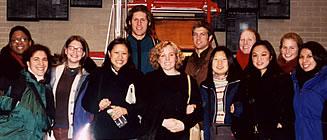 |
At a college already famous for the way it allows students to take responsibility for determining their own educations— from a no-core-curriculum policy to the high number of Special Topics courses that individual undergraduates design one-on-one with their professors—Interterm is perhaps the most independent part of the Amherst school year. An unstructured three-week period sandwiched between the fall and spring semesters, Interterm could, it is true, be used as an extended vacation; but for an increasing number of students, it has become an opportunity to try out potential post-graduation jobs. This was especially true during Interterm 2003, when several programs teamed students and alumni both on and off campus.
New this year was the Pre-Business Seminar, a three-week, on-campus course designed to give students an idea of how business careers work. Alums in the field spoke about nearly every business topic one could imagine, from venture capital and entrepreneurship to management and consulting; they served on panels, presented lectures and pointed out useful readings from the course’s text of choice, The Ten-Day MBA by Steven Silbiger. The seminar was organized by junior Paris Wallace, who said his hopes for the program were wildly exceeded. “When it first started, I was going to limit it to 40 students, and I had no idea there would be very many alums involved,” he said. “But it has become huge: 140 students, 35 alums. It went really, really well.”
Interterm offered the chance for students to gain the one thing an Amherst education does not ordinarily provide: real-life applications of theoretical business ideas, and the chance to talk to people who see them in action (for example, Robert Gibralter ’75 ’s step-by-step presentation of his 2000 Avon advertising campaign). “Amherst’s alums are its finest asset,” said Wallace. “I’m hoping people will leave with a basic business competency, and I’d like to do something again next year that involves bringing back alums who are both willing and able to teach students about their fields.” A new grant from the Mellon Foundation helped support the program, and will offer additional support for similar efforts over the next few years.
As business-oriented alumni and students came together on campus, a smaller group of alumni and students came together for the annual Winternship program in Washington, D.C. For three weeks, Winternship participants stayed with alumni who live in the D.C. area, and worked at a variety of nonprofit organizations.
So what kinds of things were these socially conscious students doing for the month of January?
“Anything nonprofit you can imagine,” Scott Laidlaw, director of the Community Outreach Program, says with a laugh. “They range from organizations working to make college more affordable for low-income students to organizations focusing on the Middle East to organizations trying to improve education in impoverished areas. The program gives students both a glimpse into what nonprofits can do, and also into the political world of D.C. in general.”
Alumni help not only by allowing students to stay in their homes, but also with a series of special events. Laidlaw spoke of alumni-led tours of the Washington Post, NPR, the Smithsonian Institution and the Holocaust Museum. “Alums have been very generous in donating their time,” he said. “They’ve helped to find a lot of internships, either by suggesting places for us to call or by offering opportunities in the organizations they work for themselves.”
Winternship began roughly 10 years ago with only four students; it has since grown to a 12-intern program for which slots are very much in demand. There were twice as many applicants for every position as there were jobs. “It’s become increasingly popular in terms of the number of applications, and also in terms of the number of organizations involved,” Laidlaw said of the program. “And more and more alumni have volunteered to house students. We’re discussing the possibility of expanding to New York City, Boston, San Francisco. There are so many students who are interested, the demand is so high, and there are so many opportunities that it would be great to expand the program.”
Assistant Director of Community Outreach Tom Lepak emphasized the ways in which this program, like the Pre-Business Seminar, gives students the chance to try something they can’t do during the regular school year. “Students still on campus are definitely still involved in community outreach work; many of those about to graduate are considering careers in nonprofit organizations,” he said. “They appreciate the chance to see if the nonprofit world is right for them, and they’re interested to see alums who have become very successful but are still so dedicated to Amherst and to the students here.”
—Rebecca Louick ’04
Photo: Scott Laidlaw
Physics Goes Mobile

Professor Emeritus Robert H. Romer is making the world a better place, one quantum-mechanics problem at a time.
Although he officially “retired” from Amherst in 2001, Romer’s schedule sounds suspiciously like that of a regular faculty member; still an active part of the physics department, he maintains an office in Merrill Science Center with piles of in-use books and papers stacked on nearly every table, desk and chair. And he has garnered quite a bit of attention for his latest project, “Thinking About Physics,” a series of questions for bus riders to ponder on their way to work. The panels feature cartoon animals posing various physics-related problems; they are the result of Romer’s collaboration with Professor John King of MIT and the artist Bruce Aller, and began appearing on Five College buses in early January. The one that appears above, for example, asks readers what will happen to the level of a pond if the characters take the anchor in their boat and drop it over the side; others in the series focus on why objects seen in a car’s passenger-side mirror are closer than they appear, or what would happen to a helium balloon inside a moving vehicle if the brakes are applied.
Physics is not a topic of conversation that ordinarily comes up during the morning commute; the general public, one could reasonably assume, is not well versed in fluid mechanics or calorimetry. But this is precisely the audience that Romer hopes to reach. “Physics can deal with atoms and molecules, the things we talk about in the classroom, but it can also deal with baseballs and tricycles and cars, everyday things,” he says. “That’s one of the things I hope this project helps people understand. To students like Michael Reed ’04, this is an important and much-needed endeavor. “People get turned off because they think they can’t handle the math and science involved in physics, which is a shame,” says Reed, a physics major from Tenafly, N.J. “The beauty of physics is that from simple things, you can understand all of nature.”
The bus panels are just the first phase of an idea Romer calls “Physics Everywhere”—an attempt to make it a part of life, even from a very early age. He talks excitedly about an “Age Zero Physics Kit,” complete with plastic screws that infants could fit together as a kind of early rotational dynamics lesson. For the school-age set, he envisions playgrounds with race paths on which children could create patterns of blinking lights and measure their own speed in meters per second.
Romer says that King shares his desire to bring physics to the masses and was enthusiastic about the larger project from the very beginning. “When my friend from MIT first talked about it, he had these grand plans of all the different things we could do,” Romer says. “I said, ‘Let’s start with physics on the subway; that’s somewhere to begin in a reasonable amount of time. We can’t put this stuff in all the playgrounds of America yet, but we can start with this project.’” Questions for the six panels were complete by June 2002; Five Colleges, Inc. and the UMass transit system allowed them to be displayed free of charge, and funding for creating and printing the posters came both from Amherst College and from Romer’s and King’s own wallets. As the number of hits on their answer Website increases, they hope to procure more funding and to get the panels onto the New York and Boston subway systems.
As his audience grows, Romer hopes to give commuters something to get their brains working during the bus or subway ride, to make their days that much more interesting. Says Romer, “I’ve always thought that people thinking about physics enjoy more of life.”
See all of Romer's physics questions and answers on his "Thinking About Physics" Website
—Rebecca Louick ’04
Illustration: Bruce Aller
College Names New Editor
Mark Cherrington has been named college editor and the editor of this magazine, succeeding long-time editor Douglas Wilson ’62, who retired in November.
Cherrington comes to Amherst from the nonprofit scientific research and education organization Earthwatch Institute, where he was the editor for 18 years, producing the institute’s international magazine and other publications. He also has pursued an active freelance writing and photography career, publishing his work in Time, Audubon and Discover, among others. He has written or contributed to a number of books on science and conservation subjects, and has given lectures on wildlife conservation at colleges and universities across the country. In the course of his work, he has reported from the remotest parts of every continent but Antarctica.
Cherrington received his undergraduate degree in English and music history from Syracuse University and his master’s degree in journalism from Boston University. Before working as an editor, he spent 10 years as a professional musician, playing drums in a wide variety of bands throughout the U.S. and overseas. He performs today on a more casual basis.
Alumni Sons and Daughters
The Admission Office has scheduled three specially arranged Dean’s Days to provide alumni and their sons and daughters with an opportunity to learn more about Amherst and its admission policies. Dean’s Days include group conversations for Amherst families with secondary school students who will be seniors in 2003-04. In addition, there will be a tour of the campus, and a light lunch will be served. Dean’s Days have been scheduled for Friday, May 30; Friday, July 11; and Friday, August 22, 2003. Pre-registration is required.
If you are not able to attend one of these Dean’s Days, you may arrange for a conversation with a dean, which would allow for discussion not only of Amherst and its admission policies, but also for discussion of the student’s interests and aspirations—all with an eye toward being as helpful as possible to the student who is going through the college admission process.
To register for Dean’s Day and for additional details about these opportunities, call Flora Chamlin at (413) 542-2328.
From the Folger
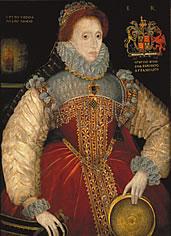 |
Without question the Sieve Portrait of Queen Elizabeth I is the most glorious painting in the Folger art collection. Its visual splendor, iconographic significance and powerful capturing of a charismatic subject guarantee it center stage in our upcoming spring exhibit, which commemorates the 400th anniversary of Elizabeth’s reign (1558-1603). One reason for emphasizing the Sieve Portrait in this space (see also page 36) is that the portrait has an Amherst connection, bequeathed to us by Francis T. P. Plimpton ’50 and received at the library in 1997. The Folger conservators sent out the portrait for professional cleaning so that years of varnish could be stripped away and the portrait’s details revealed in their full splendor. In addition, they commissioned a new, period-appropriate frame.
Painted in 1579 when Elizabeth was 46, the three-quarters-length portrait depicts the queen in what seems to me a somber or reflective mood. Her skin is pale (as usual in her portraits), her face showing little emotion, with her head turned to the viewer’s right. The painting’s visual splendor comes from the vivid play of red, white and black—the red of Elizabeth’s hair, picked up in the rich red velvet of her lavishly bejeweled gown, playing against the delicate tracery of the veil that falls from her jeweled headdress and against the flat black background in which a shadowy globe is visible. The painting’s informal title comes from the golden sieve the queen holds—somewhat awkwardly—against the folds of her skirt.
The painting has long been a personal favorite of mine because I found in the sieve an illustrative argument about the iconography of female bodies that I described in my 1993 book, The Body Embarrassed. There I argued that the sieve—known to allude to the myth of the Roman vestal virgin Tuccia, who miraculously carried water in a sieve from the Tiber to the Temple of Vesta—is a paradoxical symbol of Elizabeth’s virginity. Full of holes, the sieve refers unmistakably to the symbolically leaky, hence unreliable nature of ordinary women’s bodies even as it asserts, through its link to Tuccia, the queen’s transcendence as virgin monarch of ordinary women. For Elizabeth in her capacity as ruler, the sieve is an emblem not of leakiness but of discernment, of the good judgment requisite in rulers.
The Sieve Portrait is a fitting centerpiece for the Folger’s Great Hall exhibition. Entitled “Elizabeth I: Then and Now,” the exhibit opened to the public on March 21 and will run through August 2. Because of the Folger’s rich holdings in Elizabeth materials (the richest in North America), we are able to present a vivid documentary overview of this remarkable woman’s accomplishments and career. The exhibit features several letters in the queen’s own hand, including one in French to Henri IV and another to her cousin (and successor) King James of Scotland. There is a letter to her from Robert Dudley, earl of Leicester, one of her two great favorites, and a contemporary account of the trial of her other favorite, the ill-fated Robert Devereux, earl of Essex. Because she called Dudley “her eyes,” he affectionately inserts tiny eyebrows over words with double “o’s” into his letters and tiny eyes before his signature.
Other materials are less private, though no less fascinating, and reveal Elizabethan culture’s almost obsessive fascination with its monarch—and the fascination she has attracted ever since. The Folger owns Queen Elizabeth’s own pulpit Bible, her royal seals and a number of royal proclamations. Books in our collection include engravings in which the queen is depicted hunting, picnicking with her court, or on royal progress through the countryside. But because we are interested in tracking her symbolic afterlife as well, the exhibition will close with contemporary images and artifacts about Queen Elizabeth, including a Queen Elizabeth Barbie doll, complete with ruff and bright red hair, still ensconced in her original box. The exhibition will be open to view during the height of Washington’s tourist season, and we hope that members of the Amherst community will find an opportunity to see for themselves. The Sieve Portrait and other images from the exhibition can be viewed on the Folger Website.
—Gail Kern Paster
Verbatim
A compilation of recent remarks made at Amherst.
“And when we call to our fellow students to come out to this rally, or to come out to organizing meetings, or when we call to you here, assembled, to continue fighting for change in our country’s actions, that call is one echoed in history. It is a historical call for student involvement, for student action, grounded in necessity. Students have a very special, very vital place in this movement, and in so many recent movements. The struggles for women’s rights, for civil rights, for an end to the war in Vietnam, for the abolition of sweatshops—these are all recent movements that had as a backbone students. Students like us. We see pictures of massive rallies in Washington, D.C., from the ’60s, but we rarely ever see pictures or hear stories of students gathered on campus, sometimes just a handful, organizing rallies, teach-ins, protests.”
Marisol Thomer ’03E
at a Five College rally of students opposed to war in Iraq
November 20, 2002
“It’s difficult for conservatives on a liberal campus. Absolutely. Which is a good thing, a good thing. That’s why I came to Amherst, so I’d be challenged and I’d become a stronger thinker . . . . Amherst is a liberal liberal arts college.”
Ted Hertzberg ’04
on Fox News’ Hannity & Colmes
November 19, 2002
“Fayerweather Hall was not only a commitment by the trustees to put Amherst in the forefront of colleges adapting their curriculum to the experimental sciences, but a determined bid to get in touch with metropolitan fashion. The college had built amply but modestly for its natural history collections since the Civil War—impressive collections of fish skeletons, geological specimens and zoological collections which served a science curriculum still tied to inspiring awe for the wonders of God’s creation. Fayerweather Hall, with its spacious laboratories, was to provide a wholly new type of teaching space.”
Barry Bergdoll, professor of architecture at Columbia University
at the dedication of the newly remodeled Fayerweather Hall
November 8, 2002